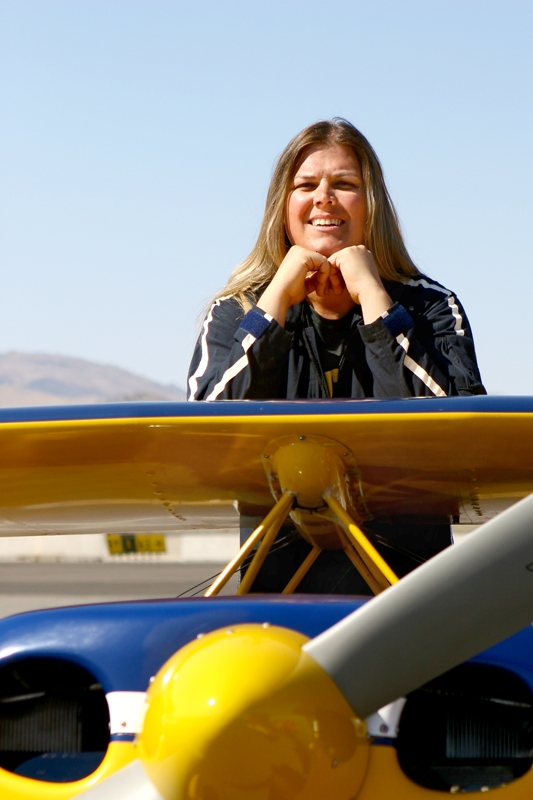 Electric aircraft racing around a three-mile oval track at nearly three hundred miles an hour in a sprint to the finish: that’s what Air Race E is promising, and that’s what pilot Casey Erickson will be flying in the first race, planned for next year.
Electric aircraft racing around a three-mile oval track at nearly three hundred miles an hour in a sprint to the finish: that’s what Air Race E is promising, and that’s what pilot Casey Erickson will be flying in the first race, planned for next year.
Erickson will be piloting a new aircraft she and her team are designing, the eponymous ER-1 Erickson Special, a single-person carbon-fibre sport plane designed for the tight corners of the Formula One air racing circuit, and based on the VSR SR-1 Snoshoo.
In addition to the electric motor — which will be provided by Airbus — the aircraft is designed and redesigned from the ground up for racing.
“We looked at the racecourse and we iteratively designed a wing so that it would be the fastest it would possibly be during the turns, and we hit our limits right at the back of the straightaway,” Erickson tells Runway Girl Network. “They don’t usually design a wing around a racecourse. But the laminar airflow, smooth airflow over the wing, differs whether you’re straight and level or on a 60-degree bank. It changes the characteristics of how the wing manoeuvres. If half the time in the race, you’re at a 60-70-degree bank angle, you’re slowing down significantly in the turns.”
The electric motor itself brings design challenges: there’s no need for exhaust, meaning the nose of the aircraft can be redesigned, and in place of fuel it needs batteries. That means changes to the weight and balance, not least because the power-to-weight ratio of the significantly lighter electric engine is “sensational” according to Erickson. The teams will, however, have to figure out how (and crucially where) to locate some 140 pounds of battery packs for the flight.
“We have not been given the electrical motor yet, but they’re working on it,” Erickson says, noting that Airbus’ involvement in the race as official founding partner has echoes in the history of air racing.
“My understanding is that Airbus is leading the way when it comes to air taxis, electrical aircraft, et cetera,” Erickson says. “What they need is data, and the best way to get data and push technology forward has always been racing. In the 1930s, in the heyday of air racing here in the United States, aircraft got pushed forward, technology got pushed forward, so fast. Air racing was huge, it was bigger than baseball, it was the biggest thing happening in the 1930s.”
The technologies advanced in air racing led to airframe, powerplant, structure and technique advances that proved vital in World War II, and air racing today sits in the context of the chief technology officers of seven of the world’s leading aviation businesses — Airbus, Boeing, Dassault, General Electric, Rolls-Royce, Safran and UTC — leading a call for the industry to work towards a “third age” of advances in new technologies, architectures, propulsion, materials and manufacturing.
It’s a big move for a small girl whose grandfather owned an avionics shop at the airport in Carlsbad, California, where Erickson first caught the aviation bug.
“There’s a restaurant right over his shop, and my mom would take me to visit my grandpa and we’d eat lunch at the restaurant. I don’t remember ever saying that I wanted to be a pilot, or was going to be a pilot, although my mom says I said that!” Erickson laughs. “But I do remember, and this is when I’m like 6, 7, 8 years old or whatever, and I remember looking up at the tiny little airplanes that were probably just in the traffic pattern, probably just student pilots, and going: ‘yeah, that one’s going to go to China, that one’s going to Russia, that one’s going to South America’ and to me that’s where I thought they were going. I just assumed, because if I had a little airplane, that’s where I’d go! Obviously, range-wise, they can’t go more than a couple of hundred miles!”
Over a decade later, she took a demo ride and, after a move to Seattle, started flying lessons, and that’s still what she recommends for anyone who loves the sound of air racing.
“If you want to get involved immediately, get involved with one of the race teams. We’re always looking for help, we’re always looking for people on the teams,” Erickson explains. “Contact a team. I’m always looking for somebody to help! We could almost always use more help.”
Erickson, who chuckles at a suggestion that she could really use someone to get involved with social media, can contact her via Air Race E and welcomes email to casey.ann.erickson@gmail.com.
But, “if you want to be the monkey at the stick,” says Erickson, “number one, you’ve got to go out and you’ve got to learn to fly. You’ve got to get good at it, you’ve got to be at the top of your game. One mistake, at these speeds in these aircraft? You have to know exactly what you’re doing.”
Related Articles:
- Will Dash 8 hybrid-electric X-plane hit the spot for green aviation?
- Skyborne helps 19-year old Alisha Jassar pilot her way to airline career
- Ignoring bad advice, Stephanie Burn on achieving her piloting dream
- First woman to cross the Atlantic in LSA shows spirited resolve
- Aero Space adventure lifts off for students in rural Scotland
- Solo at 16: Ellie Carter does the hard work for a flying career
- Aerospace education and adventure take flight in heart of Scotland
- Embry-Riddle racers rev up for the 2018 Air Race Classic
- Melissa Myers: Why I’ve set my sights on becoming a pilot














